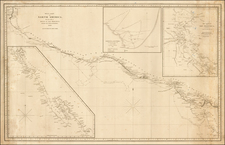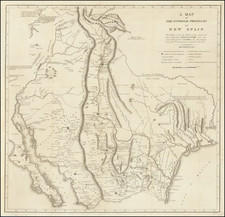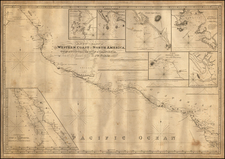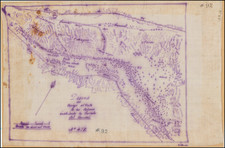Scarce 19th century Baja California Land Promotional
The International Company's Lands in Lower California
A very scarce 19th century promotional work for Baja California, extolling the International Company's vast land concession, declaring the lands "now open to colonists." Several variants of this publication have been described. The present issue, certainly one of the earliest, was likely printed in 1887, or late 1886. The press notices herein are dated 1886-1887, with the latest one, from the Anglo-American Times, dated Sept. 17, 1886. One side of the folded sheet comprises 12 panels of text, each panel equivalent to a page of text, describing the agricultural resources and development potential of Baja California. The text describes the success of several American farmers, including German Senter, who first came to California in 1859, settling in the peninsula of Baja California a few years later. Other people mentioned: Luretta Amado of the Santo Tomas Valley; Louis Aguilar; C. L. Shields, who came from Kentucky to set up a ranch in the Los Animas Valley; L. Mendelson, of the San Rafael Valley; Charles Bennett, from Tennessee, E. B. Higgins, of New York, J. A. Rice, of National City, and several others. In addition to referring to fruit and vegetable growing, the present issue includes a section on honey production, which is not found in all issues of this work:
Honey. So thickly are all of the lands covered with blossoms of various wild flowers, clovers and so forth, that honey can be produced in any quantity marketable.
Background on Baja California colonization schemes
The prospect of colonizing Baja California began in earnest shortly after the discovery of Gold in 1849. Perhaps the most noteworthy of these attempts was undertaken by William Walker, a San Francisco Lawyer and serial filibuster. In June 1853, Walker, a pro-slavery advocate, applied to the Mexican Government for a land grant, which was declined. Walker thereafter recruited a group of adherents of Manifest Destiny who were mostly from Kentucky and Tennessee. The filibusters sought to establish an independent republic in part of Mexico, which might ultimately become one of the states of the United States allowing enslaved people, in the fashion of the Republic of Texas. Walker and his supporters conquered La Paz, capital of Baja California, then set up as the President of the Republic of Baja California, with his capital in Ensenada. His efforts to take Sonora (and create the Republic of Sonora) failed and he was forced out of Mexico and tried in the United States for conducting an illegal war under the Neutrality Act of 1794. He later tried the same thing in Nicaragua in 1856, before his attempts to take over Honduras resulted in his execution in 1860.
The second major effort to colonize Baja California was undertaken by the Lower California Company. The Company was formed to take over a land grant contract originally negotiated in 1864 by Jacob P. Leese, in order to exploit the mineral resources of Baja California. The company enlisted John Ross Browne and a group of scientists to survey Baja California. The report from the scientists was largely unfavorable and the Lower California Company ultimately had its grant rescinded by the Mexican Government in 1871, for failure to attract sufficient settlers to the region.
Between 1880 and 1888, several similar concessions were granted, which eventually coalesced as the International Company of Mexico. The largest of these component concessions was to Louis Hüller, a Mexican citizen, granted in 1884, comprising 5.5 million hectares in the area bordered on the south by the 29th parallel, and to the north by the international border. Subsequently another concession, of 700,000 hectares, granted originally to Adolf Bülle in 1884, would also add to the International Company's holdings. A third, comprising 1.4 million hectares, was granted to Flores, Hale & Co.
George H. Sisson, who served as General Manager of the International Company and whose name appears on the title panel of the present pamphlet, was an interesting figure and seems to have been the mainspring behind the operation and one of it's key financial backers. A native of Cass County, Michigan, Sisson made a fortune in Arizona mining before becoming involved in Baja California colonization schemes.
The present publication notes that interested parties should "report at the [San Diego] office of the International Company of Mexico, First National Bank Building (Chas. Scofield, Agent), where transportation will be provided to Ensenada." The San Diego connection is important. According to David Piñera, one can understand the International Company's colonization venture in terms of the context of Southern California's land boom cycle of development, to which is was inextricably linked:
[the International Company's] land and speculation activities were closely linked to the phenomena of demographic and economic expansion in Southern California, including San Diego, a city close to the border. That same area was going through a considerable population increase due to the real estate boom... Under those circumstances, neighboring Baja California was looked upon by real estate promoters as a favorable field to extend that boom. Emphasis was given to the international border region and the bay of Ensenada, whose location and beauty were ideal for urbanization and to capture the interest of American clients. Advertisement notes can be found in the newspapers of that time that mention Ensenada as "the second San Diego."
The end of the Southern California land boom precipitated the collapse of Baja California land prices, which eventually led to the reorganization of the company. David Piñera attributes the downfall of the company at least partially to Sisson's poor management of the enterprise. Such factors led to the firm morphing into an English company. On May 11, 1889, the International Company ceded all properties and debts to the Mexican Land and Colonization Company, Limited, known in Mexico as La Compañía Inglesa.
Maps.
The two maps are titled:
Map of Lands of the International Company of Mexico, Lower California showing Railroad Connections. Robert Aikman of New York.
Map of Lands of the International Co. of Mexico Located in Lower California. Hosford & Sons, N.Y.
Halftone photographic images.
[1]. Live Oaks, and Valley Slope, on the Peninsula. [2]. Uplands on Peninsula. [3]. Orange Grove a Few Years Ago. [4]. 130 Year Old Olive Trees, Santo Tomas. [5]. Date Palm Near Ensenada. [6]. Banana Plants in December, Near Ensenada.













![[La Paz / Estero de Agiabampo / Santa Maria Cove] Ports of the Gulf of California](https://storage.googleapis.com/raremaps/img/small/73352.jpg)


![[Baja California--Cabo San Lucas] Amer. Sep. No. 58 Partie De La Vielle Californie [and] Amer. Sep. No. 63 Partie De La Vielle Californie](https://storage.googleapis.com/raremaps/img/small/100744.jpg)